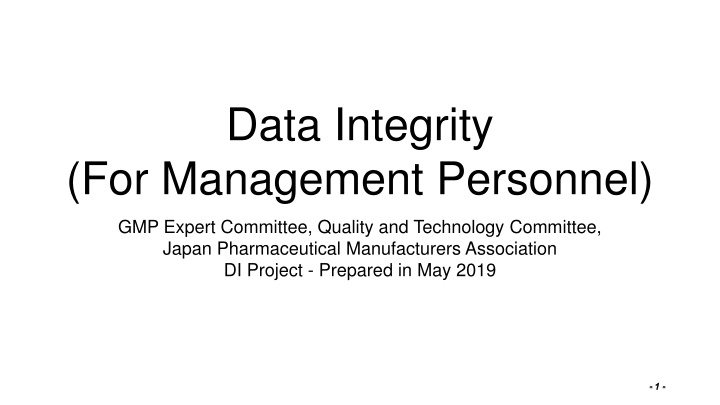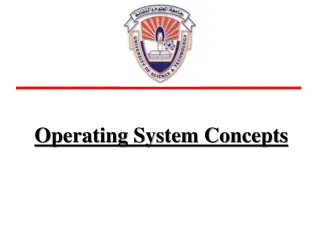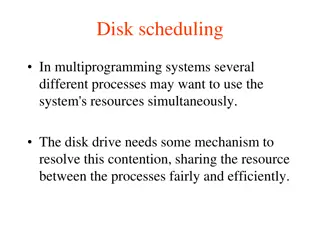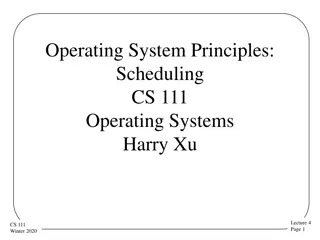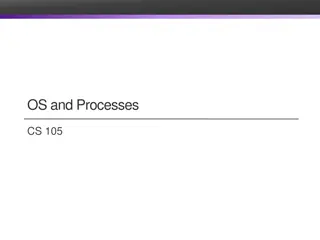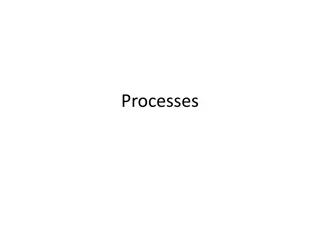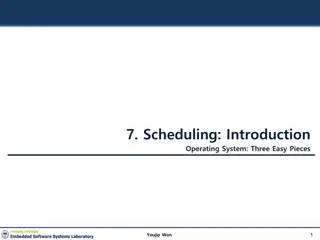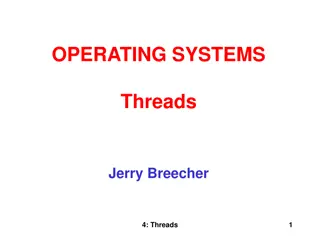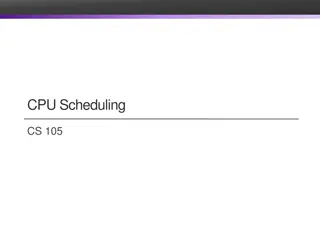Operating Systems Scheduling Processes Overview
This content provides insights into process scheduling in operating systems, covering topics such as process control blocks, ready queues, scheduler functions, evaluation criteria, and scheduling policies. Understanding these concepts is crucial for efficient system management and optimization.
Download Presentation

Please find below an Image/Link to download the presentation.
The content on the website is provided AS IS for your information and personal use only. It may not be sold, licensed, or shared on other websites without obtaining consent from the author.If you encounter any issues during the download, it is possible that the publisher has removed the file from their server.
You are allowed to download the files provided on this website for personal or commercial use, subject to the condition that they are used lawfully. All files are the property of their respective owners.
The content on the website is provided AS IS for your information and personal use only. It may not be sold, licensed, or shared on other websites without obtaining consent from the author.
E N D
Presentation Transcript
Data Integrity (For Management Personnel) GMP Expert Committee, Quality and Technology Committee, Japan Pharmaceutical Manufacturers Association DI Project - Prepared in May 2019 - 1 -
Table of Contents Data Integrity - Why must we comply with this? Image and Definition of Data Integrity Data Governance Systems Organizational Impact General Impact Code of Ethics and Quality Culture PQS Elements - 2 -
Data Integrity Why must we comply with this? https://encrypted-tbn2.gstatic.com/images?q=tbn:ANd9GcR5g-U7vhfHgn0ZGAMjftQoOjpt-viycnW48j2e3LsSSAlHsgHAyhTnyA Reliability Marketing authorization holder (MAH) Patients and medical institutions - 3 -
Data Integrity Why must we comply with this? Comparison of quality assurance methods Inspection result: Conforming Consumers Home appliances, Functional testing of all items etc. 5 non-conforming units These are not placed on the market 100,000 units manufactured Consumers can perceive quality defects when they use the product. Testing and inspection of some of the tablets Some are lost due to destructive testing. Test results: Conforming All are guaranteed by data. 500 tablets for testing Pharmaceutical products, etc. Patient 999,500 tablets 1 million tablets manufactured Quality defects that patients can perceive are limited to appearance, taste, smell, etc. Patients would are not be able to tell even if the drug product contains only half of the specified amount of API or it is contaminated with other ingredients. - 4-
Data Integrity Why must we comply with this? It makes it possible to track operations. Follow procedures Perform the operations At the same time Leave contemporaneous records Complete, (data) demonstrate the quality of the products we deliver to the market and earn the trust of patients and medical institutions! consistent and accurate records Records (data) . . . are the only proof that the operations were performed in accordance with the procedures. - 5-
Data Integrity Why must we comply with this? Start Late 1980s Generic Drug Scandal => It was revealed that the wrong data were provided by a pharmaceutical company in connection with bribery! => This led to enormous fines, impact on stock prices, and obstacles to business operations! ! Early 1990s Application Integrity Policy (FDA) => Guideline on Integrity of Application Data issued! After 2010 => More rigorous inspections for API plants in India and China, which are major suppliers for US products! Expanded scope of data integrity! (FDA) Quality cannot be guaranteed at companies that cannot produce correct data. Defects at suppliers directly lead to products stockout. - 6-
Data Integrity Why must we comply with this? Ratio of DI related warnings among Warning Letters Total/Count Since 2015, the percentage of Warning Letters related to data integrity has been decreasing! But it is still over 40%! Business Year Source: FDA website - 7-
Data Integrity Why must we comply with this? Increasingly, the findings from PMDA s GMP inspections cite deficiencies in document control and records. In particular, from 2016 to 2017, deficiencies in document control and records which is the top finding have increased rapidly from 25 cases to 41 cases. 2017 "GMP Case Study Meeting" From the lecture by PMDA. Compliance with data integrity is basically routine for GMP activity . . . But still deficiencies are being observed. Corporate compliance with data integrity is inadequate!! - 8 -
Data Integrity Why must we comply with this? If compliance with data integrity is neglected . . . In some cases, a product recall occurs and the company loses a great deal! Expenses incurred in recall and compensation (economic loss) Corporate reliability (loss of social credibility, fall in stock prices) Markets for the product (and other products as well) (reduction/loss of share), etc. Depending on the cause of the recall, patients' lives may be endangered! - 9 -
Data Integrity Why must we comply with this? If compliance with data integrity is neglected . . . "Bill for Partial Revision of the Act on Securing Quality, Efficacy and Safety of Pharmaceuticals, Medical Devices, Regenerative and Cellular Therapy Products, Gene Therapy Products, and Cosmetics" (submitted in the 198th Diet [ordinary session] on March 19, 2019) Maintain a system to supervise operations at manufacturers. Clarification of which officers are responsible for pharmaceutical affairs duties (responsible officers) at manufacturers => Management responsibility for legal compliance will be questioned. - 10 -
Data Integrity Why must we comply with this? Company Name Discovered in Items involved Pharmaceutical product (tablets) Pharmaceutical product (human serum albumin preparation) Pharmaceutical product (injection) Air bag Inflator Misconduct committed in Overview Manufacturing with wrong ingredients (erroneous mixing of API and excipients) Samples were intentionally replaced during release testing. Company A March 2010 February 13, 2009 Falsification of data in approval application dossier and manufacturing (PV) data. (Data replacement) Company B April 2010 2008 Part of the quality testing was deliberately omitted when the product was released (untested) Tampering with performance test data for inflator (= gas emitting device) Concealment of signs leading to rupture of parts Tampering with performance data for fire resistance of insulation panel Tampering with performance data for seismic isolation rubber Fraud involving rubber vibration insulator (for railway cars) Failure to test seat ring of ship valve Blood products were manufactured by methods different from those specified in the approval dossier, and false manufacturing records were created and covered up. Data were tampered with 360 out of 3052 cases of pile driving work. A total of 2382 piles were subject to data tampering. 196 employees were involved (including 61 field managers). Tampering with fuel consumption data for 4 types of light automobiles Submission of fraudulent data as part of re-measurement data Inspection by unqualified inspectors Inspection by unqualified inspectors Data tampering for product inspection certificates and omission of inspection process Laboratory data tampering, non-inspection, concealment Product inspection data tampering 149 cases Company C January 2011 2007 to 2010 2000 to 2008 (2004) (2007) March 2015 October 2015 February 2017 Company D September 2014 Company E March 2015 Seismic isolation rubber, etc. Pharmaceutical products (blood products) Company F May 2015 1980s to May 2015 Company G October 2015 Pile driving work 2005 to 2015 Company H April 2016 Fuel consumption 1991 to 2016 Company I Company J September 2017 September 2017 Invalid inspections Invalid inspections Past 38 years Past 30 years Company K October 2017 Aluminum products 1970s to October 2017 Company L November 2017 Semiconductor parts Tire cords Automobile hoses Fuel consumption and exhaust gas Exhaust gas Fuel consumption and exhaust gas Seismic isolators/vibration control devices (Hydraulic dampers) Industrial lead storage batteries Semiconductor materials and 29 other products June to October 2017 April 2008 to September 2016 Company M November 2017 Company N March 2018 2013 to 2018 Tampering with fuel consumption and exhaust gas measurement data Company O July 2018 2013 to 2018 Tampering with exhaust gas measurement data for 19 types of automobiles Tampering with exhaust gas measurement data and fuel consumption data in pre- shipment inspection Company P September 2018 2000 to 2008 February 2001 to September 2018 Product inspection data tampering 995 seismic isolators, 110 vibration control devices Company Q October 2018 June 2018 November 2018 Company R 1970s to 2018 Product inspection data tampering - 11 -
Data Integrity Why must we comply with this? By what route do you aim to reach the mountaintop? And what will you do on the way? Construction of a quality management system Compliance system D I D I D I D I D I D I D I D I - 12 -
Table of Contents Data Integrity - Why must we comply with this? Image and Definition of Data Integrity Data Governance Systems Organizational Impact General Impact Code of Ethics and Quality Culture PQS Elements - 13 -
Image and Definition of Data Integrity (1) Ensuring the reliability of data throughout the data lifecycle Key Points Management is responsible for establishing a data governance system and fostering a quality culture to ensure data integrity Data Integrity Management review and approach using quality risk management as components of Pharmaceutical Quality System (PQS) Data Governance Systems Organizational Impact Creation of a transparent and open workplace environment (quality culture) where employees can freely communicate failures and mistakes, including those that involve data reliability, and can take corrective and preventive action - 14 -
Image and Definition of Data Integrity (2) Data Integrity: The extent to which all data are complete, consistent and accurate throughout the data lifecycle Data Lifecycle: All phases in the life of the data (including raw data) from initial generation and recording through processing (including transformation and migration), use, data retention, archiving/retrieval and destruction High Data Integrity Data Lifecycle Accuracy Processing (including analysis/conversio n/migration) Generation/ Recording Retenti on Archiving & retrieval Use Destruction Low Key Points Data integrity should be ensured throughout the data lifecycle - 15 -
Data Governance Systems (1) Data Governance: The sum total of arrangements to ensure that there is data, irrespective of the format in which it is generated, is recorded, processed, retained and used to ensure a complete, consistent and accurate record throughout the data lifecycle Data Lifecycle Data Integrity High Processing (including analysis/conversion/ migration) Generation/ Recording Accuracy Archiving & retrieval Use Retention Destruction User authorization Audit trail review Product Release Filing Control of document storage cabinets Procedure for record destruction Low Rules for entering GMP records CSV Application dossier Setting of record retention periods Data server management Data governance - 16 -
Data Governance Systems (2) Data governance system: System to achieve data governance integrated into Pharmaceutical Quality System (PQS) Data Integrity Key Points It is the responsibility of management to implement a data governance system that ensures data integrity. Data Lifecycle Data governance Documentation as an element of PQS PQS Review and reconsideration of the data governance system CAPA system Data governance systems PQS elements Change management Management review Data criticality Data risk Method for achievement Quality Risk Management - 17 -
Organizational Impact on Data Integrity Data Integrity PQS Data governance systems Quality risk management Responding to data integrity issues Resource allocation Periodic management review of quality metrics Quality Culture Ethical standards and policies - 18 -
General Impact Key Points Management needs to understand the following: Legal and moral responsibility to prevent and detect loss of data integrity The direct and indirect* risk factors that impact data integrity and how to deal with them *: For example, incentives for production exceeding process capability Management "awareness and comprehension" of data integrity Impact on successful management of data integrity Data Integrity Data governance systems Risk Responding to data integrity issues Management Periodic management review of quality metrics Resource allocation Quality Culture Ethical standards and policies - 19 -
Ethical Standards and Policies Key Points Management needs to understand the following: Documentation of values, ethics and codes of conduct Informing employees on what roles they play in data integrity, product quality assurance and patient safety, and how important those roles are Including in the Code of Conduct examples of actions unfavorable to the integrity of the data and how such actions are handled Establishment of a whistle-blowing system for data integrity Data Integrity Data governance systems Risk Responding to data integrity issues Management Periodic management review of quality metrics Resource allocation Quality Culture Ethical standards and policies Creating an environment of trust that reflects management philosophy on quality, in which all employees are responsible for ensuring patient safety and product quality - 20 -
Quality Culture Key Points Management needs to understand the following: Maturing Quality Culture Organizational reporting structure where information can be shared among employees at all levels Involvement of management itself in the maturing of Quality Culture Data Integrity Data governance systems Quality Risk Management Responding to data integrity issues Periodic management review of quality metrics Resource allocation Quality Culture Ethical standards and policies Transparent and open workplace where all employees can freely communicate failures and mistakes - 21 -
PQS Elements: Quality Risk Management Key Points Management needs to understand the following: Application of Quality Risk Management and appropriate data control standards to PQS Development of PQS to address complex data generation issues PQS should be able to prevent/detect/correct data integrity risks. Data Integrity Data governance systems Responding to data integrity issues Quality Risk Management Periodic management review of quality metrics Resource allocation Quality Culture Ethical standards and policies Applying Quality Risk Management and good data management practices to PQS - 22 -
PQS Elements: Periodic Review of Quality Metrics Key Points Management needs to understand the following: Periodic review of performance indicators; and identification, escalation and addressing of significant events Selection of appropriate performance indicators that do not reduce the priority of data integrity Direct communication about risks to senior management by head of quality unit Data Integrity Data governance systems Quality Risk Management Responding to data integrity issues Periodic management review of quality metrics Resource allocation Quality Culture Ethical standards and policies Management reviews quality metrics on a regular basis to identify, escalate and address significant events - 23 -
PQS Elements: Resource Allocation Key Points Management needs to understand the following: Allocation of resources so that excessive workloads or pressure do not create data integrity issues Securing sufficient personnel necessary for management oversight, IT support, etc. Purchase of equipment, software, etc. necessary for complying with ALCOA + and fulfilling data integrity requirements, and implementation of education for employees Data Integrity Data governance systems Responding to data integrity issues Quality Risk Management Periodic management review of quality metrics Resource allocation Quality Culture Ethical standards and policies Allocating appropriate resources to enable employees to continuously manage data integrity - 24 -
PQS Elements: Handling Data Integrity Issues Key Points Management needs to understand the following: Evaluation of impact on product quality should be based on scientific evidence. Loss of data integrity should be handled as a PQS deviation, and root cause investigation and CAPA should be performed. Corrective actions for deviations should include reporting to authorities and notifying customers when necessary. Data Integrity Data governance systems Responding to data integrity issues Quality Risk Management Periodic management review of quality metrics Resource allocation Quality Culture Ethical standards and policies Handle as a PQS deviation - 25 -
